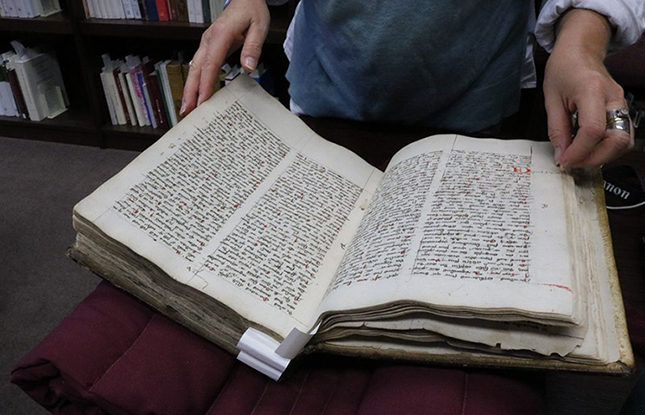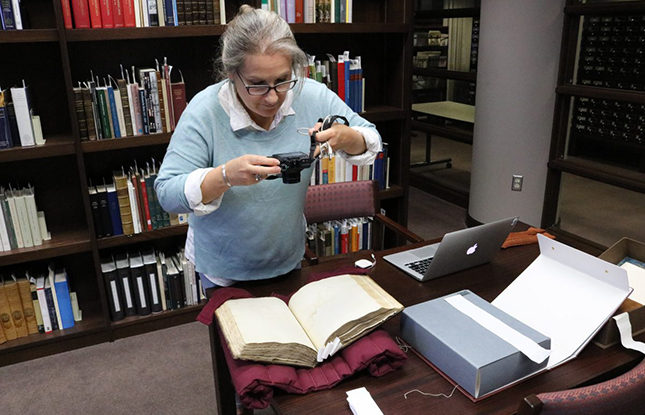Water stains. Coffee stains. Ink stains. What is that? stains. The Library of Stains project, also known as Labeculae Vitae, is lifting the mystery of stains in manuscripts from around the world and looking beneath the surface to see what stories those marks may tell.
The project aims to gather scientific data from the process of multispectral imaging, drawing from stains found on parchment, paper, and bindings in medieval manuscripts. The data from these images could offer a new way for researchers, conservators, librarians, and the public to access information about both the material makeup and use of medieval manuscripts, as well as new approaches for modern manuscript studies.
“Multispectral imaging is being used to study the degradation of parchment and pigments,” said Heather Wacha, Ph.D., Council on Library and Information Resources (CLIR) Postdoctoral Fellow in Data Curation for Medieval Studies. “But to harness this technology to identify a dataset of stains in this manner has never before been explored.”
The Library of Stains project will focus on “dirty old books,” literally. It will look at the stains and dirt residues that have traditionally been overlooked when studying these types of artifacts.On December 13, a special public lecture and multispectral imaging demonstration will be held in the Department of Special Collections, on the ninth floor of Memorial Library, 10:00-11:30 a.m., giving the public a first-hand glimpse of the project and its process.
Some examples of stains team members hope to find include medicinal spills, blood, and even ingredients from alchemical recipes. The folios that have been chosen to image and analyze include stains of interesting shapes, colors and placement. For example, a medium-sized stain that begins on the edge of a page and washes across the bottom right corner may indicate spilled wine or another liquid; whereas a small irregular-looking dark stain placed in the middle of a page may be the remnants of an insect accidentally crushed when the book was closed.
“This project wants to bring together an audience to explore and study the human experience,” explained Wacha. “Who hasn’t spilled something on a book or project that they’ve been using? Imagine what your books will reveal about you 100, 200, 1,000 years from now. Whether it’s a medieval person’s relationship to a manuscript or how that information relates to our interactions with books today, this project gives us a new way to experience and understand those who came before us.”
Who hasn’t spilled something on a book or project that they’ve been using? Imagine what your books will reveal about you 100, 200, 1,000 years from now.
The project was awarded a $10,000 grant from the Mellon foundation that supports innovative projects proposed by CLIR Fellows. Erin Connelly (University of Pennsylvania), Alberto Campagnolo (Library of Congress), and Heather Wacha (University of Wisconsin-Madison), all CLIR Postdoctoral Fellows in Data Curation for Medieval Studies are collaborating with Mike Toth, multispectral imaging expert from R. B. Toth and Associates. The group will image approximately 35-40 manuscripts held in their respective institutions. R.B. Toth Associates, in partnership with Digital Transitions and Phase One A/S have developed a multispectral imaging system for libraries and librarians who desire to conduct their own spectral imaging of important collection objects and cultural heritage artifacts. Results from this project are expected to be released early in 2018.
The public may attend the demonstration for free. For those unable to attend the lecture but would like to see the imaging process, or for media interested in the story, Heather Wacha is available on December 11 and 12.
For more information, visit the Center for the History of Print and Digital Culture.
Story courtesy of the UW-Madison Libraries.
More on medieval manuscripts
Read more about how researchers in L&S are using technology to foster connections among medieval maps and manuscripts to unlock secrets of the past — and potentially revolutionize how humanities scholarship takes shape in the future.



